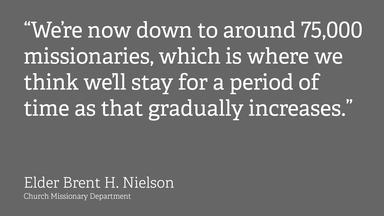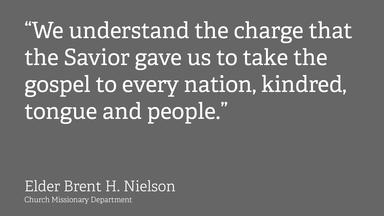As millions of Latter-day Saints around the world prepare for the 186th annual general conference of the Church, Elder Brent H. Nielson of the Seventy and executive director of the Missionary Department of The Church of Jesus Christ of Latter-day Saints sat down for an interview in mid-February to reflect on the progress of the Church’s missionary program.
Media initiatives, the use of technology and the age requirement change have bolstered the missionary efforts of the Church in the past several years.
“We work regularly to make sure that people know about our church and understand what we believe,” said Elder Nielson.
Downloadable HD 1080p SOTs of Elder Brent H Nielson for Journalists
Missionary Surge Subsides
There are currently about 75,000 full-time missionaries serving in more than 400 missions in many countries. Over the past five years, about 230,000 missionaries have completed their missions and 1.3 million have served since the Church was organized in 1830.
“At the beginning of this year, we had 418 missions in the Church,” reported Elder Nielson. “We've just created the Vietnam Mission, which is now officially in place, and by July we will have created two other new missions in Africa, which will give us a total of 421 missions.”
After the age requirement for young men and women was lowered in October 2012, the missionary force hit a record high of nearly 89,000 men, women and senior couples. Young men can now serve at age 18, and women can begin their service at age 19.

“As that surge passed, we're now down to around 75,000 missionaries, which is where we think we'll stay for a period of time as that gradually increases,” he said.
Many of the missionaries who were part of the surge have now returned home following their service, which is 18 months for women and two years for men.
“That stretched our resources; it stretched our mission presidents just to take care of that many missionaries, even though we had created 58 new missions to do that,” said Elder Nielson.
- Missionary Update 2016
- Missionary Update 2016
- Missionary Update 2016
- Missionary Update 2016
- Missionary Update 2016
- Missionary Update 2016
- Missionary Update 2016
| Temple Square is always beautiful in the springtime. Gardeners work to prepare the ground for General Conference. © 2012 Intellectual Reserve, Inc. All rights reserved. | 1 / 2 |
Not only the young men answered the call to serve in greater numbers, but also more young women decided to share the gospel and serve in leadership capacities.
“I don't ever want to downplay our elders because they're amazing, but these sister missionaries are really quite incredible. And we are so grateful to have the large numbers that have come,” said Elder Nielson. “In every mission now we have what's called sister training leaders. And they're called to supervise a number of sisters in the mission. They're part of the mission leadership council. So every month when the mission president meets with the leaders, those sisters are there.”
There are currently 6,200 senior missionaries supporting the missions, and Elder Nielson said more are needed. “We need more; we always hope for more. And we encourage more senior couples to come.”
In addition, 20,000 sisters are serving missions, which is around 30 percent of the missionary force.
Keeping Missionaries Healthy and Safe
There is also a team of 500 medical advisers and providers who look after the mental and physical health of the missionaries. They are led by Elder Gregory A. Schwitzer of the Seventy, a medical doctor. Many of the missions also have nurses on duty to assist the missionaries.

“The well-being and safety of our missionaries is perhaps the most important thing that we do here in the Missionary Department,” said Elder Nielson, explaining that the medical providers watch for viruses or illnesses that may be reported in specific areas. “We have regular communication with our mission presidents and their wives, who provide the daily care for our missionaries.”
Elder Nielson said missionaries are moved if an area is deemed unsafe.
“If there are issues about safety, geopolitical issues with other things that might happen in a country, our security department gives us daily briefings here in the Missionary Department,” he said. “The same thing happens with severe weather. If we see a typhoon or a hurricane coming, we try to make sure our missionaries are prepared, that they're in a safe place and that we're watching out for their safety at all times.”
Elder Nielson said a small percentage of missionaries return home early due to medical needs or other concerns. “Missionaries don't necessarily want to come home from their mission early, so this is always a difficult time, and our hope would be that our Church culture would be that we love them and care for them as they come home early from their missions.”
Missionary Media Initiatives
In addition to ongoing missionary efforts, the Missionary Department has been sponsoring seasonal media campaigns to reach broader audiences. Church leaders hope the latest “Follow Him” media initiative scheduled for the Easter season will be as successful as previous Christmas and Easter initiatives, which focused on the birth and Resurrection of Jesus Christ.
“Those initiatives really are to try to educate people about Jesus Christ and our love of Him and His message,” said Elder Nielson.
In December, the “A Savior Is Born” Christmas initiative reached millions of people globally through social media, displays in visitors’ centers, missionary pass-along cards, online paid promotion and outdoor advertising in New York City’s Times Square. As a result of the initiative, thousands of people asked for more information about the Church or for missionary visits.
“Fifty-four million people viewed that video, which was incredible,” he said, adding that it also gave Latter-day Saints, "a tool that they can use on Facebook or other places where they can share it with their friends."

Technology in the Field
While the Church is using social media and technology to reach larger audiences through LDS.org and Mormon.org, more missionaries are using digital devices such as iPads for planning and teaching. “We have digital devices in 87 of our missions,” said Elder Nielson. “They can show videos during their lessons; they can use the digital devices for their scriptures. They can use the digital devices to find people to teach and to communicate with members.”
Church leaders were recently able to use the Internet to gather all of the missionaries for a live broadcast. “We will continue to communicate more with our missionaries in that way,” he said. Prior to that event, a similar broadcast was recently conducted for mission presidents and their wives.
Before and After the Mission
The Missionary Department is making the transition for missionaries easier before they leave on their missions with new missionary preparation courses that will soon be available.
An online course for missionaries returning home after their service is also being introduced. "We realized that many times they wonder how do I take this wonderful experience I've had as a missionary and translate that into my life today?" said Elder Nielson. "We've come up with a wonderful online course that's called My Plan."
The course allows missionaries in the last six weeks of their missions to develop post-mission goals for scripture study, temple attendance, education and dating.
Convert Baptisms
“There are areas of the world where our baptisms are very high, and they continue to stay very high,” he said “And then there's areas of the world that are more secular [where] it's difficult for our missionaries to do missionary work. But we understand the charge that the Savior gave us to take the gospel to every nation, kindred, tongue and people, and we do that.”
Church leaders continue to be impressed with the caliber of missionaries who are serving. “I'm so delighted to see how prepared, how humble, how teachable, how willing these young men and young women are. We love them. They're our rising generation, and they are incredible,” said Elder Nielson.
“Our missionaries are always focused on their purpose, which is to invite others to come unto Christ through faith, repentance, baptism, receiving the gift of the Holy Ghost and enduring to the end. … And it was actually the purpose of the Savior when He was on the earth. Even though they may be using digital devices or other methods to share the gospel, our message stays constant with those things,” concluded Elder Nielson.